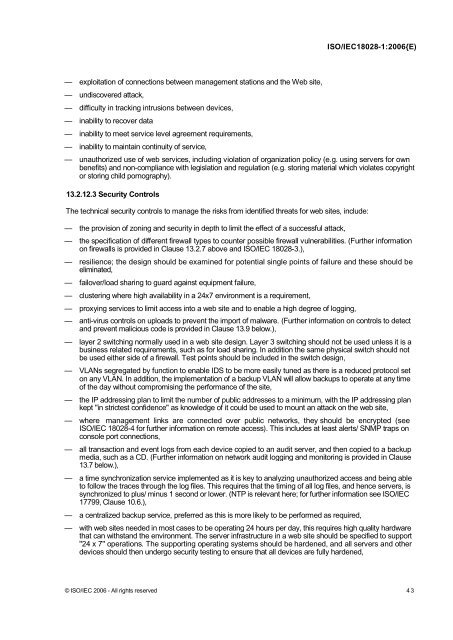INTERNATIONAL ISO/IEC STANDARD 18028-1
INTERNATIONAL ISO/IEC STANDARD 18028-1
INTERNATIONAL ISO/IEC STANDARD 18028-1
- No tags were found...
You also want an ePaper? Increase the reach of your titles
YUMPU automatically turns print PDFs into web optimized ePapers that Google loves.
<strong>ISO</strong>/<strong>IEC</strong><strong>18028</strong>-1:2006{E)— exploitation of connections between management stations and the Web site,— undiscovered attack,— difficulty in tracking intrusions between devices,— inability to recover data— inability to meet service level agreement requirements,— inability to maintain continuity of service,— unauthorized use of web services, including violation of organization policy (e.g. using servers for ownbenefits) and non-compliance with legislation and regulation (e.g. storing material which violates copyrightor storing child pornography).13.2.12.3 Security ControlsThe technical security controls to manage the risks from identified threats for web sites, include:— the provision of zoning and security in depth to limit the effect of a successful attack,— the specification of different firewall types to counter possible firewall vulnerabilities. (Further informationon firewalls is provided in Clause 13.2.7 above and <strong>ISO</strong>/<strong>IEC</strong> <strong>18028</strong>-3.),— resilience; the design should be examined for potential single points of failure and these should beeliminated,— failover/load sharing to guard against equipment failure,— clustering where high availability in a 24x7 environment is a requirement,— proxying services to limit access into a web site and to enable a high degree of logging,— anti-virus controls on uploads to prevent the import of malware. (Further information on controls to detectand prevent malicious code is provided in Clause 13.9 below.),— layer 2 switching normally used in a web site design. Layer 3 switching should not be used unless it is abusiness related requirements, such as for load sharing. In addition the same physical switch should notbe used either side of a firewall. Test points should be included in the switch design,— VLANs segregated by function to enable IDS to be more easily tuned as there is a reduced protocol seton any VLAN. In addition, the implementation of a backup VLAN will allow backups to operate at any timeof the day without compromising the performance of the site,— the IP addressing plan to limit the number of public addresses to a minimum, with the IP addressing plankept "in strictest confidence" as knowledge of it could be used to mount an attack on the web site,— where management links are connected over public networks, they should be encrypted (see<strong>ISO</strong>/<strong>IEC</strong> <strong>18028</strong>-4 for further information on remote access). This includes at least alerts/ SNMP traps onconsole port connections,— all transaction and event logs from each device copied to an audit server, and then copied to a backupmedia, such as a CD. (Further information on network audit logging and monitoring is provided in Clause13.7 below.),— a time synchronization service implemented as it is key to analyzing unauthorized access and being ableto follow the traces through the log files. This requires that the timing of all log files, and hence servers, issynchronized to plus/ minus 1 second or lower. (NTP is relevant here; for further information see <strong>ISO</strong>/<strong>IEC</strong>17799, Clause 10.6.),— a centralized backup service, preferred as this is more likely to be performed as required,— with web sites needed in most cases to be operating 24 hours per day, this requires high quality hardwarethat can withstand the environment. The server infrastructure in a web site should be specified to support"24 x 7" operations. The supporting operating systems should be hardened, and all servers and otherdevices should then undergo security testing to ensure that all devices are fully hardened,© <strong>ISO</strong>/<strong>IEC</strong> 2006 - All rights reserved 43
















